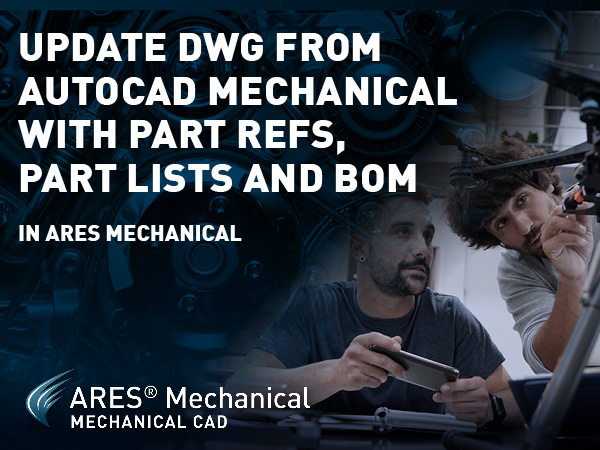Update DWG from AutoCAD Mechanical with Part Refs, Part Lists and BOM in ARES Mechanical
- 10/02/2022
- Posted by: Graebert
- Category: Videos

Update & Modify 2D drawings created in AutoCAD Mechanical using ARES Mechanical
Nowadays, new product design is most frequently done with 3D CAD solutions. But in parallel, billions of older 2D mechanical drawings need to be maintained. In this blog, we will see how we can use ARES Mechanical to update and modify 2D drawings that were created with AutoCAD Mechanical.
Part-references and how to edit it?
Let’s start with part references, which are represented here with blue points. With a double-click, we can edit the part ref information. In this dialogue we can, for example, click on Customize to add another field for the Vendor and slightly modify the description. We see here a quantity of 1. If the same part is inserted multiple times, we can change the quantity here.
Copy part-reference
Alternatively, we can copy a part ref several times in a quantity of 1, like this. Now we see the quantity of 4 in the Parts List, and the description we modified. When we select the part ref again, we see that the data can also be read and edited from there. In the next blog, we will see how we can add other standard parts from our library.
Make a part ref from any entity
But for now, let me show you that we can also make a part ref from any entity. Let’s say we need to add some silicone to protect the head of this screw from water. Here, we are designing a polyline that we will turn into a spline. Next, we select to create a part reference. Note that we could also create one from a block. We insert the part ref and add a name and description.
BOM feature
Now let’s take a look at the BOM feature. We validate by pressing Enter to select the Main one. To begin with, we see some elements in blue.
Overridden data
If we fly over with the cursor, we will see that it is highlighting data that is overridden. In some cases, there is a good reason. For instance, our drawing follows the DIN standard, and this part was shown with ISO reference, so we entered the DIN equivalent.
To keep the names as overrides
Similarly, we want to keep these names as overrides, because originally it was empty. Now, pay attention to this quantity of 2 for our screw. If we press this button we can remove the override, and it shows now as 1. We apply the change for now, but in our drawing, we do have two screws. Yet, only one part reference is inserted. To fix the quantity, we open the part ref and increase it to 2. Now our BOM is showing the right value.
Insert an item inside the BOM
To continue, we can also insert an item directly inside the BOM. For example, we are adding the painting that we will need. Inserting items like this is typically useful when no part ref can be linked. Finally, we have the option to remove items from the parts list, such as silicone. We add the Vendor column.
Parts-list
Now that our BOM is well configured, let’s take a deeper look at the parts list. We can insert the parts list using this feature in the ribbon. But in this drawing, the parts list is already inserted, so we simply double-click on it. To begin with, we will insert the Name and Vendor columns that we see are missing. Note that we can only insert columns for fields enabled in the Parts Reference dialogue. We can always update the information from here, but the modification will then be highlighted in blue.
Zoom to & Highlight buttons
When this list becomes very long, it is sometimes difficult to identify each part. Therefore, the Zoom to and Highlight buttons are here to help us find the corresponding items in the drawing. Note that we see here this screw highlighted in blue because it is the one that has a part reference.
Balloon number
Finally, the Item column shows the balloon number. We will hear more about balloons in the next blog, but for now, let’s try changing this value. When we do so, we can see the number in the corresponding balloon changes as well. After validating our changes, we see the parts list was also updated with the two additional columns.
Revisions table
To document our changes, we will now create a revisions table. We can insert revisions to highlight what was changed.
Frames & create a new frame
But now we realize that our drawing doesn’t fit in this frame anymore, so let’s create a new frame with larger paper size. Frames are also mechanical entities following the standard we are working on. The frame includes a title block with attributes that we can update.
Summary
To summarize, we have seen in this blog post that we can update the information contained in the mechanical entities. Try out the features of ARES Mechanical by downloading a trial version.